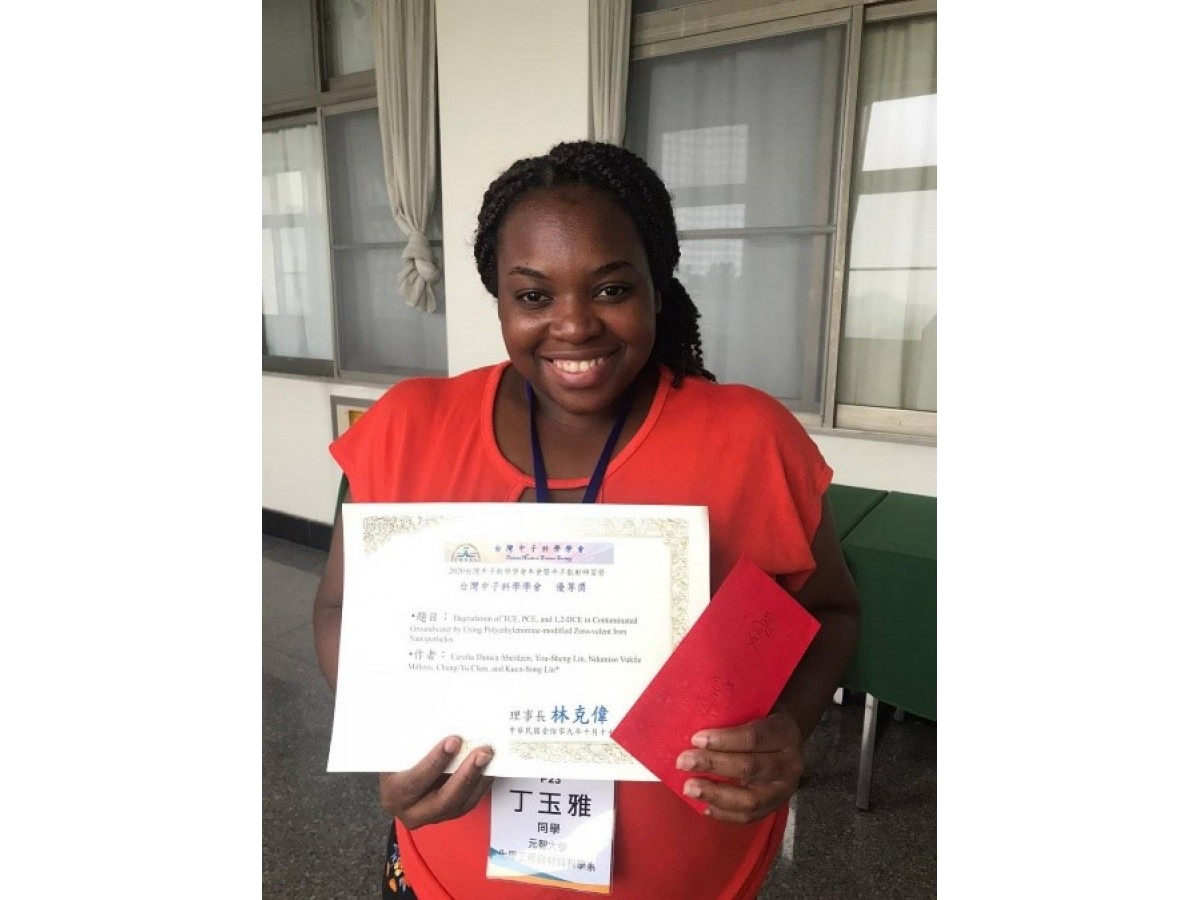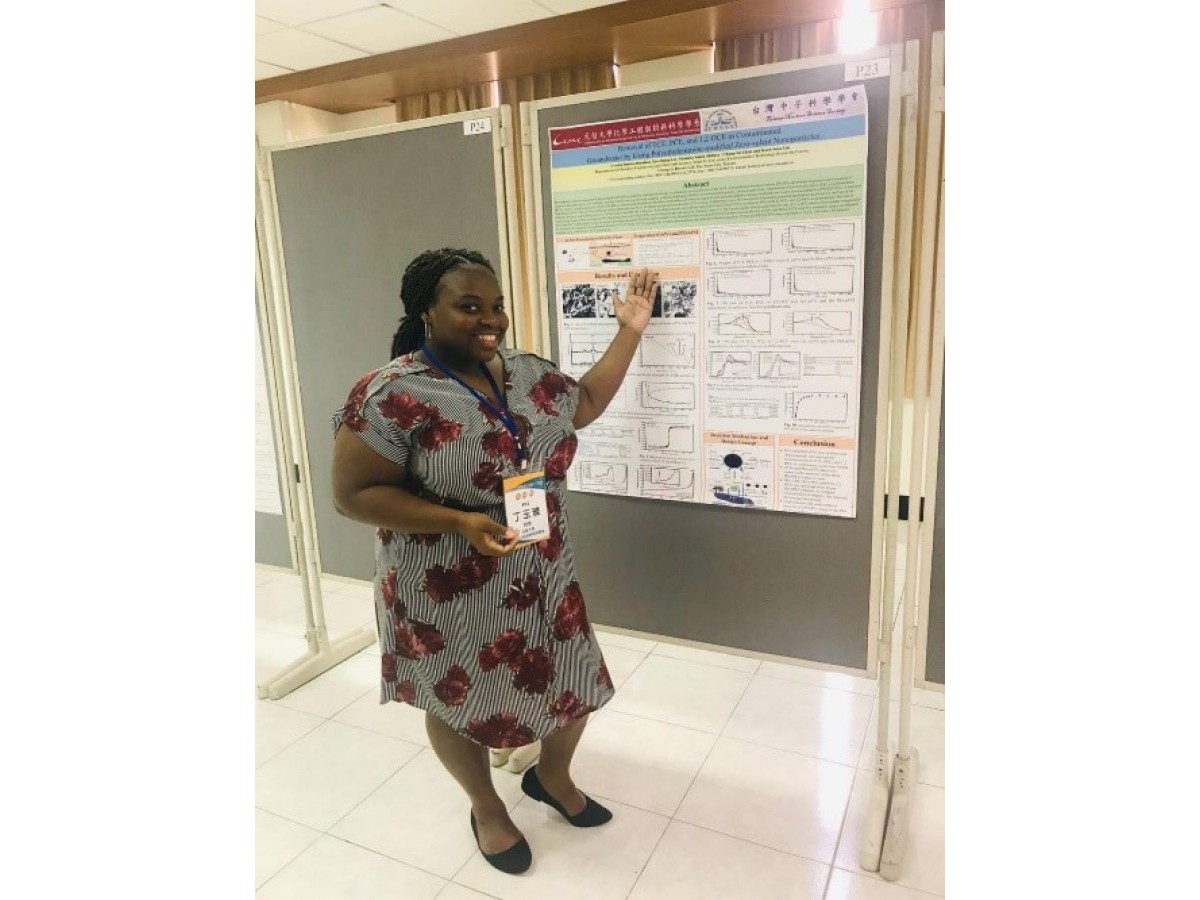Congratulations! Cerelia Aberdeen won Silver Award at the 2020 Taiwan Neutron Science Society Annual Conference and Seminar Poster Competition. Cerelia Aberdeen
Cerelia Aberdeen, a graduate student of the Enviromental NanoCatalyst laboratory, under the guidance of her Professor, Lin, Kun-Song, represented the Department of Chemical engineering and materials science at the 2020 Taiwan Neutron Science Society (TWNSS) annual conference by presenting the topic ‘Removal of TCE, PCE, and 1,2-DCE in Contaminated Groundwater by Using Polyethylenimine-modified Zero-valent Nanoparticles’in the form of a poster.
Each year, the Taiwan Neutron Science Society provides both local and international students with the opportunity of showcasing their research areas through the use of a conference and poster presentation. The conference offers various students from different research backgrounds, the opportunity to come together with the opportunity of both receiving new knowledge through various conference sessions and presenting their own research in great detail.
Last year, Cerelia Aberdeen under the guidance of her Professor, Kuen-Song Lin, attended the 2020 TWNSS annual conference and represented the department of Chemical Engineering and Materials Science through the presentation of a poster titled ‘Removal of TCE, PCE, and 1, 2-DCE in Contaminated Groundwater by Using Polyethylenimine-modified Zero-valent Nanoparticles’. Throughout the years, there has been a significant increase in the number and level of contaminants in soil and groundwater. The raising level of these contaminants have several disastrous impacts on both the human population and the environment. A consistent contaminant found in the bottom of aquifers is known as dense non-aqueous phase liquids (DNAPLs). Such contaminants are of great concern due to their higher density than water and low solubility in water, causing them to form an impermeable layer which is difficult to remove. With this in mind, the Environmental Nanocatalyst laboratory led by Professor Kuen-Song Lin, have devoted several years of research finding ways for the cost-effective removal of such contaminants by the use of the nanomaterial, zero-valent iron (nZVI).
At the 2020 TWNSS conference, Cerelia presented research surrounding the removal of DNAPLs by the use of a polymer-coated nZVI. She highlighted that while nZVI is considered to be a popular reducing agent due to its high reactivity and low cost, it still presents several disadvantages. Such disadvantages are based on the magnetic interaction between particles which lead to agglomeration reducing their surface area, and reactivity with surrounding contaminants. In addition to this, agglomeration reduces the distance that the nanoparticle can travel and as such can react with the oxygen and water in the surrounding atmosphere before interacting with the contaminant at the bottom of the aquifer. The research presented that the disadvantages of nZVI could be solved by coating polyethylenimine (PEI) on the surfaces of nZVI particles in order to form PEI-nZVI composite materials. The research presented highlighted the methodology of producing this composite material, the characterization of the material by use of FE-SEM/EDS, FTIR and XANES coupled with several other techniques and batch reductive studies of the DNAPLs, TCE, PCE and 1, 2-DCE using the PEI-nZVI material.
The poster highlighted various aspects of the research such as results obtained for both characterization of the polymer-coated nZVI and reductive dechlorination mechanism of for both nZVI and PEI-nZVI. Cerelis’s presentation continuously compared the results of the polymer coated nZVI to that of fresh nZVI in order to demonstrate that several aspects of the newly coated nZVI were superior to that of its counterpart. These aspects included a reduction in agglomeration, a larger surface area and a greater reduction of contamination even in high concentration levels of contaminants. She showed that based on the research over 95% of 1,2-DCE at a concentration of 50 and 100 mg/L were removed within 10 min in reaction with fresh nZVI, whereas the number for PCE and TCE was 93% and 90%,
respectively. These percentages decreased at higher concentrations of the contaminants due to the passivation of nZVI. However, in the case of PEI-nZVI after 2 h, both concentration levels reached the same values of 97%, 96%, and 96% for TCE, PCE, and1, 2-DCE, respectively. She highlighted that this was due to the protective role of the polymer to the catalyst. The presentation also highlighted the comparative XPS studies that indicated surface modification of the nanoparticle and a possible mechanism by which dechlorination occurred.
Cerelia was extremely excited to take part in the 2020 TWNSS as this was her first time attending a conference. She was extremely grateful to the various Professors who shared their research during the sessions and the presentation of different techniques that could be used to improve her own research. She noted that international participation was valued and welcomed in all areas and was excited to interact with scientist from different parts of the world. Cerelia received a silver medal for her poster presentation during the conference.



